The three volume-set LNCS 11476, 11477, and 11478 constitute the thoroughly refereed proceedings of the 38th Annual International Conference on the Theory and Applications of Cryptographic Techniques, EUROCRYPT 2019,held in Darmstadt, Germany, in May 2019.
The 76 full papers presented were carefully reviewed and selected from 327 submissions. The papers are organized into the following topical sections: ABE and CCA security; succinct arguments and secure messaging; obfuscation; block ciphers; differential privacy; bounds for symmetric cryptography; non-malleability; blockchain and consensus; homomorphic primitives; standards; searchable encryption and ORAM; proofs of work and space; secure computation; quantum, secure computation and NIZK, lattice-based cryptography; foundations; efficient secure computation; signatures; information-theoretic cryptography; and cryptanalysis.
